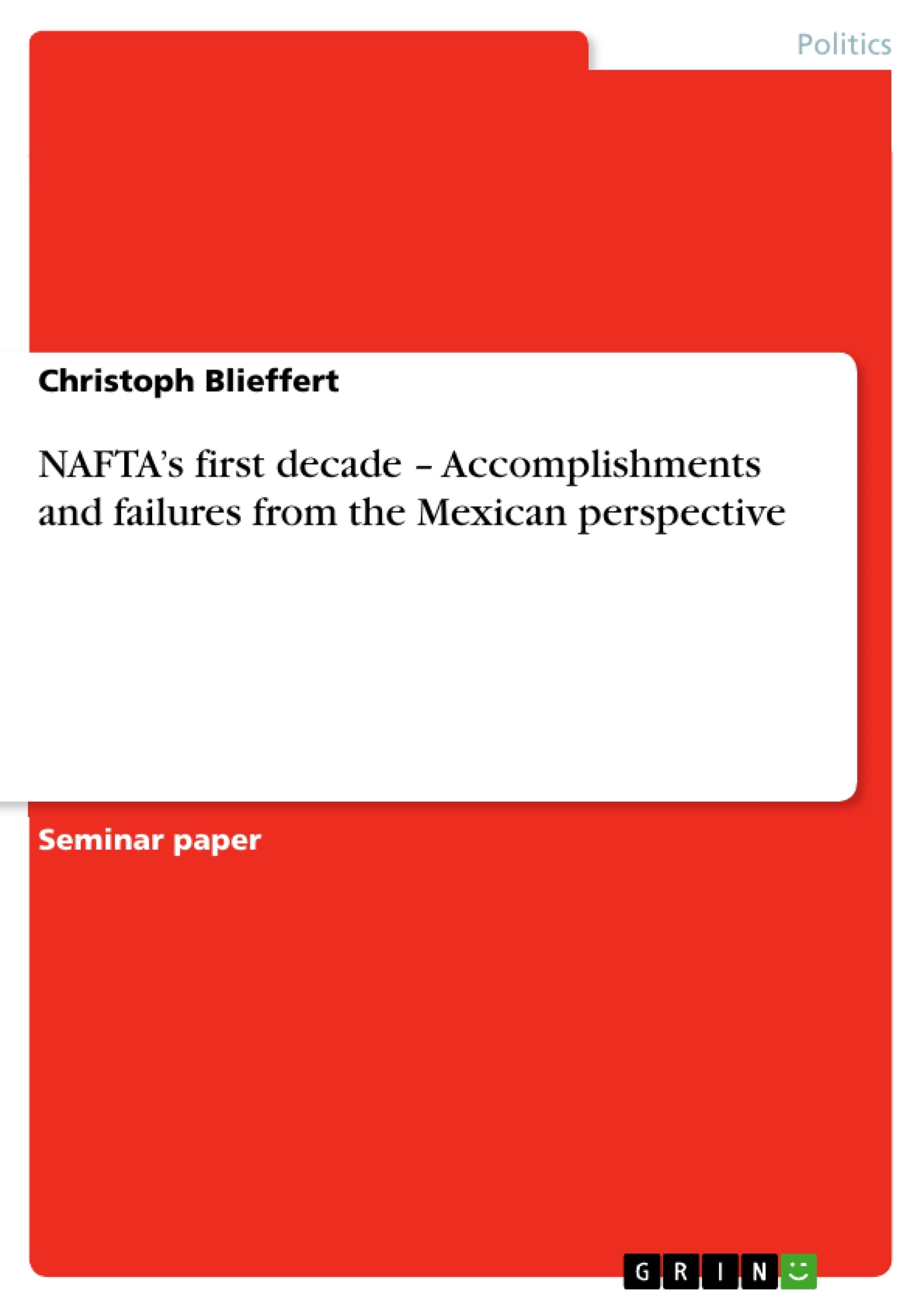On January 1, 1994, Mexico, Canada, and the United States established the largest free
trade area under the North American Free Trade Agreement (NAFTA) after two and a half
years of negotiation. This agreement created a free trade area on the North American
subcontinent with approximately 431 million inhabitants and a GDP of about $15.3 trillion in
2006. NAFTA represented an important milestone in global trade policy, not just because of
the sheer size of the free trade area it has created, but also with regard to the
comprehensiveness of the agreement. It covered not just merchandise trade but also issues
related to investment, environmental policies, energy generation, and labor markets.
NAFTA’s primary goal was the creation of a free-trade area with free movement of
goods, service and capital, but no common market. In order to prevent the abuse of different
external import tariffs, NAFTA implemented strict rules of origin. NAFTA is focused on
economic cooperation and does not - in contrast to the European Union - intend a deeper
political integration or the transfer of national sovereignty to a supranational organization.
The creation of NAFTA is based on the fact that three countries, despite different size,
economic structure, and ethnical background pursued the same goal, the establishment of a
closer regional economic integration. Differences in economic terms between the member
countries can be clarified by the distribution of NAFTA’s GDP in 2006. More than 86.2
percent of NAFTA’s total GDP was generated by the United States whereas Mexico
contributed only 5.5 percent, which reflects the state of Mexico’s economic development.
Additionally, the Mexican GDP per capita amounted to only 18 respectively 20 percent of the
GDP per capita in the United States and Canada.4 This heterogeneity between the three
participating countries may be the most significant aspect of this agreement.
This paper discusses NAFTA’s accomplishments and failures after its first decade from
the Mexican perspective as the agreement has been confronted with skepticism from its
inception until today. While Mexican officials understood NAFTA as a measure to modernize
the country through free trade, critics feared the transformation of the Mexican economy to a huge maquiladora where investors are mainly focused on the exploitation of Mexico’s low
labor costs.5 Since the beginning of negotiations, Mexico’s former President Salinas has
raised high expectations on the Mexican side in economic and social terms with his statement:
“The whole point of NAFTA for Mexico is to be able to export goods and not people. That
means creating jobs in Mexico.” In order to highlight whether NAFTA resulted in economic
as well as social improvements, this paper focuses on a comparison of these two aspects.
Inhaltsverzeichnis (Table of Contents)
- 1. Introduction: NAFTA's first decade - Accomplishments and failures from the Mexican perspective
- 2. Mexico - an emerging country in the shadow of the USA.
- 2.1 Mexico - A flagging economy before NAFTA
- 2.2 Mexico's motivation for joining NAFTA.
- 3. NAFTA's impact on Mexico's economic development
- 3.1 Trade
- 3.2 Foreign direct investments
- 4. NAFTA's impact on Mexico's social issues.....
- 4.1 Employment and wages
- 4.2 Living conditions in rural areas...
- 4.3 Environmental aspects …………….
- 4.3.1 Political dimension of the environmental side agreement
- 4.3.2 Real dimension of the environmental side agreement
- 5. NAFTA - A first balance after one decade.......
Zielsetzung und Themenschwerpunkte (Objectives and Key Themes)
This paper examines the accomplishments and failures of the North American Free Trade Agreement (NAFTA) from the Mexican perspective, focusing on the first decade after its implementation in 1994. The paper analyzes whether NAFTA has led to economic and social improvements in Mexico, considering the skepticism surrounding the agreement from its inception. The work aims to highlight the impact of NAFTA on Mexico's economic development, including trade, foreign direct investments, employment, wages, and environmental issues.
- Mexico's economic situation prior to NAFTA and its motivations for joining the agreement.
- The influence of NAFTA on Mexico's economic development, including trade and foreign direct investment.
- The social impacts of NAFTA on employment, wages, and environmental issues in Mexico.
- NAFTA's effectiveness and limitations in promoting economic and social progress in Mexico.
- A comparative assessment of the achievements and shortcomings of NAFTA from the Mexican perspective.
Zusammenfassung der Kapitel (Chapter Summaries)
The first chapter introduces NAFTA and its establishment in 1994, outlining its objectives and scope. It highlights NAFTA's importance in global trade policy and its unique features, including coverage of not just merchandise trade but also investment, environmental policies, energy generation, and labor markets. It emphasizes NAFTA's goal of creating a free-trade area with free movement of goods, services, and capital, while maintaining strict rules of origin to prevent abuses. The chapter also discusses the economic disparities between the member countries, particularly Mexico's lower GDP per capita compared to the United States and Canada, and frames the paper's focus on NAFTA's accomplishments and failures from the Mexican perspective.
Chapter two delves into Mexico's economic conditions before NAFTA, highlighting the country's historical challenges, including inequality in wealth distribution, a failing democratic regime, and a lack of an emancipated labor movement. Despite achieving high levels of economic growth in the past, Mexico struggled to address its income disparities and suffered from economic recessions in the 1980s. The chapter also explores the motivation behind Mexico's decision to join NAFTA, analyzing the potential benefits for the country's economic modernization.
Schlüsselwörter (Keywords)
NAFTA, Mexico, free trade, economic development, trade, foreign direct investment, employment, wages, environmental issues, social impacts, inequality, economic modernization, maquiladoras, rule of law, political dimension, environmental side agreement, real dimension, achievements, failures, skepticism, Mexican perspective.
- Arbeit zitieren
- Christoph Blieffert (Autor:in), 2007, NAFTA’s first decade – Accomplishments and failures from the Mexican perspective, München, GRIN Verlag, https://www.grin.com/document/90941



